You need swim ratings because water exposure without proper protection can destroy your wearable’s internal components through electrical shorts and corrosion. Water pressure increases by one atmosphere every 10 meters, potentially compromising seals and affecting sensor accuracy. Chlorinated pools and saltwater create aggressive chemical environments that degrade gaskets and metal components over time. Without appropriate IP67 or 5 ATM ratings, you’re risking expensive device failure and voiding your warranty coverage completely.
Understanding IP and ATM Water Resistance Standards for Swimming Wearables
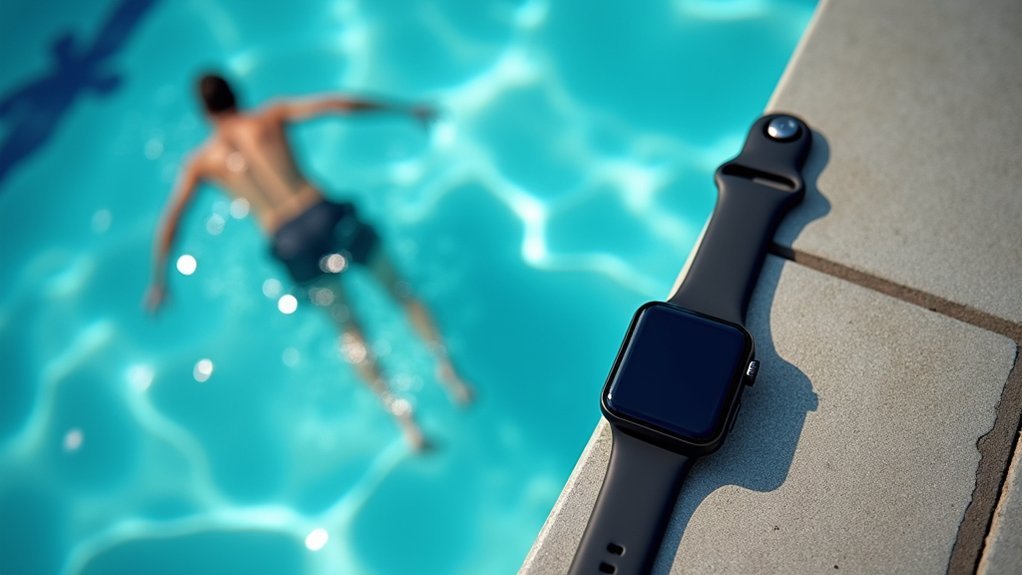
When choosing a swimming wearable, you’ll encounter two distinct water resistance standards that aren’t interchangeable: IP ratings and ATM ratings.
IP ratings assess protection against dust and water using two-digit codes, focusing on splash resistance and brief shallow immersion without considering water pressure effects. They’re perfect for rain or sweat but inadequate for swimming activities.
ATM ratings specifically quantify static water pressure resistance in atmospheres, simulating actual swimming depths under ISO standards. While IP67 protects against 1-meter immersion for 30 minutes, 5 ATM indicates genuine swim-appropriate resistance at 50-meter pressure equivalents.
You’ll need ATM ratings for aquatic activities because IP protection alone can’t handle underwater pressure from swimming movements, potentially causing water damage despite seeming waterproof. However, even devices with high ATM ratings may experience reduced survivability as sealing materials age and potentially sustain damage over time.
The Science Behind Waterproof Testing for Athletic Timepieces
When you’re shopping for a swim-ready wearable, you’ll encounter water resistance standards that manufacturers must validate through rigorous scientific testing protocols.
These tests subject your device to controlled pressure environments that simulate underwater conditions, but the methods reveal important limitations you should understand. Laboratory testing uses dry tests that measure case expansion under increased air pressure and wet tests that monitor for air bubbles during water immersion.
Beyond basic waterproofing, you’ll also need to take into account how water exposure affects your device’s ability to maintain consistent signal quality during athletic activities.
Water Resistance Standards
Although your fitness tracker might look sleek and modern, its ability to survive your morning swim depends entirely on rigorous scientific testing protocols that most consumers never see.
When you’re shopping for swimming wearables, you’ll encounter IP68 ratings, which guarantee your device can handle immersion beyond one meter depth for extended periods. These ratings aren’t arbitrary—they’re backed by ISO 2281 compliance and JIS B 7023 standards that manufacturers must meet.
The testing process involves electrical conductivity tests that detect water penetration and hydrostatic pressure tests that simulate real swimming conditions.
You’ll also find thermal shock tests ensuring your device won’t fail when shifting from cold pool water to hot showers. This standardized approach means you can trust that different brands meet identical waterproof criteria.
Remember that water resistance ratings indicate static water resistance, not performance during dynamic swimming activities where water pressure and movement create additional stress on seals.
Pressure Testing Methods
Before your athletic timepiece earns its water resistance rating, it must survive precise pressure testing that simulates the exact forces you’ll encounter during swimming and diving.
Two primary methods validate your device’s waterproof integrity: dry and wet testing.
Dry testing uses compressed air to pressurize your watch’s chamber while sensors detect minute case expansion. If your timepiece remains compressed without re-expanding, it’s watertight.
Wet testing submerges your device in distilled water under pressure, then releases it to check for escaping bubbles. Any bubbles indicate potential failure.
Both methods require your crown to be fully secured and pressure levels matching your device’s resistance rating.
These rigorous tests guarantee your wearable withstands real-world aquatic conditions before reaching your wrist. Following wet testing, a condensation test checks for any moisture that may have penetrated inside the case.
Signal Quality Challenges
While your waterproof timepiece passes pressure tests with flying colors, it faces an entirely different challenge once electronics enter the equation: maintaining crystal-clear signal quality. Water’s higher dielectric constant and absorption properties wreak havoc on wireless signals, while waterproof coatings alter antenna impedance matching and resonance frequencies.
| Challenge | Impact |
|---|---|
| Waterproof seals | Signal attenuation and distortion |
| Flexible materials | Irregular gaps affecting stability |
| Water ingress | Short-circuit risks and interference |
| Underwater operation | Reduced signal strength |
You’ll find that even minimal water penetration creates interference in signal pathways. Flexible wearable materials compound the problem by creating pressure points that destabilize sensor readings. Manufacturers must balance waterproofing requirements with antenna performance, ensuring your device maintains connectivity whether you’re swimming laps or checking notifications poolside. Advanced non-destructive testing methods help manufacturers identify potential failure points before devices reach consumers, providing the reliability needed for daily use across various environments.
How Water Pressure Affects Wearable Performance at Different Swimming Depths
When you swim at different depths, water pressure directly impacts your wearable’s sensor performance and measurement accuracy.
The deeper you go, the more hydrostatic pressure compresses sensor housings and potentially alters calibration settings that affect data collection. Pressure increases by 14.5 pounds per square inch for every 33 feet you descend underwater.
Your device’s heart rate monitors and motion sensors can experience signal interference or dampening effects that compromise the reliability of your swim metrics.
Pressure Impact on Sensors
As you dive deeper into swimming pools or open water, hydrostatic pressure increases by approximately one atmosphere every 10 meters, creating significant challenges for your wearable device’s sensors.
This pressure can physically deform sensor housings, compromising seals and causing water ingress that deteriorates accuracy. Your device’s calibration parameters may shift, leading to erroneous physiological readings during swimming.
Different sensor types respond uniquely to pressure changes. Optical heart rate sensors face altered light absorption due to pressure-driven tissue compression, while accelerometers and gyroscopes experience changed internal dynamics.
Capacitive sensors may show altered electrical properties under elevated pressure conditions. Advanced sensors like the LPS33HW can withstand pressures up to 20 times their normal operating range, making them suitable for demanding underwater environments.
Signal transmission also suffers as pressure causes attenuation or distortion, reducing measurement precision.
That’s why manufacturers design pressure-resistant enclosures with specialized materials to preserve sensor functionality underwater.
Depth-Related Accuracy Changes
Because water pressure compounds exponentially with depth, your wearable’s performance accuracy deteriorates in predictable patterns that directly correlate with how far below the surface you’re swimming.
As you dive deeper, increased water density alters your device’s sensor readings by affecting skin contact stability and changing buoyancy forces that shift your wearable’s position.
Your heart rate sensors become less reliable at depth because water pressure influences skin perfusion and heart rate variability.
Motion sensors like accelerometers and gyroscopes lose precision as altered joint angles and limb velocities from pressure changes skew their calibrations. Proper device placement becomes critical since most accurate wearables are positioned on the lower back or head for optimal swimming kinematics tracking.
Optical sensors suffer from reduced ambient light and increased water turbidity at greater depths, while your device’s wireless connectivity weakens as denser water attenuates radio frequency signals.
Critical Differences Between Water Resistant and Waterproof Swim Watches
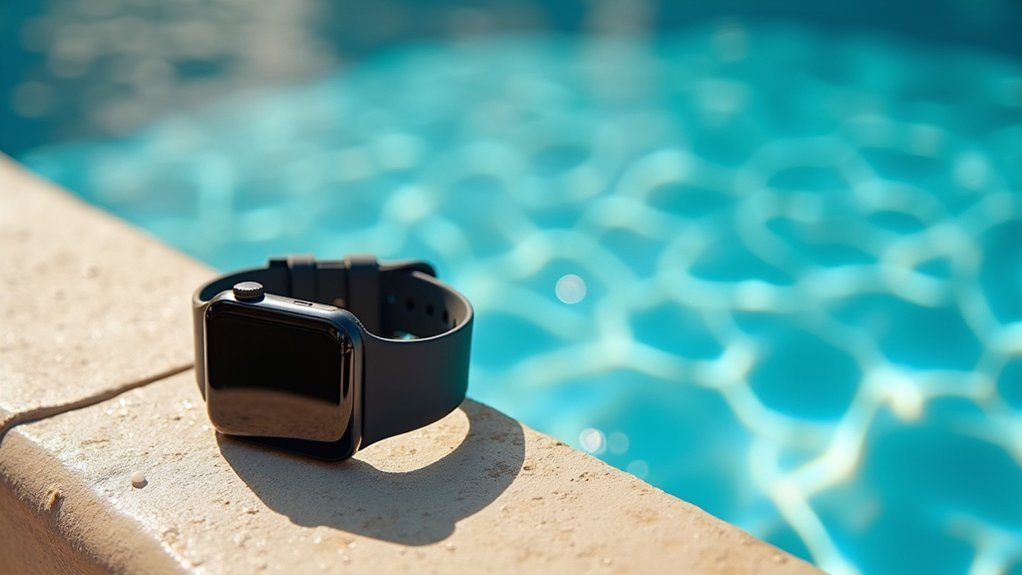
Most consumers confuse water-resistant and waterproof swim watches, yet understanding their fundamental differences can save you from costly damage and disappointment.
Water-resistant watches handle splashes and brief immersion during daily activities, while waterproof watches withstand prolonged submersion. However, no watch is truly 100% waterproof indefinitely.
| Feature | Water-Resistant | Waterproof |
|---|---|---|
| Best Use | Hand washing, rain | Swimming, diving |
| Testing Method | Air pressure simulation | Actual water immersion |
| Depth Rating | 30m (splash only) | 100m+ (true depth) |
| Durability | Limited exposure | Extended underwater use |
You’ll notice that “30m” ratings don’t actually mean swimming depth—they’re splash-resistant only. Dynamic pressure changes during swimming challenge water-resistant watches beyond static test conditions, making proper rating selection essential for your intended activities. The major cause of waterproof watch failure is seal degradation, which occurs when rubber or plastic seals weaken over time.
Temperature Variations and Their Impact on Wearable Seal Integrity
While your wearable’s IP rating indicates its water resistance at room temperature, extreme heat and cold can compromise seal integrity in ways that standard testing doesn’t reveal.
Cold temperatures challenge your device’s seal flexibility, making them brittle and prone to cracking under stress. Meanwhile, hot, humid conditions can cause seal creep and failure, creating micron-sized holes that allow water ingress.
Temperature extremes make device seals brittle in cold or cause them to creep and fail in heat, compromising water protection.
Thermal cycling between temperature extremes accelerates material fatigue in adhesives and encapsulants, gradually weakening your device’s protective barriers. Different sterilization methods can actually improve some adhesive properties, suggesting that certain manufacturing processes may enhance seal durability under stress.
You’ll notice this degradation first during swimming or sweating, when compromised seals allow moisture to penetrate your wearable’s housing. This ingress damages internal components, affects sensor accuracy, and can cause electrical shorts.
That’s why understanding temperature’s impact on seal integrity is essential for maintaining your wearable’s swim rating performance.
Chemical Resistance Requirements for Pool and Open Water Swimming

When you’re swimming in chlorinated pools or saltwater environments, your wearable faces aggressive chemical exposure that can destroy seals and compromise functionality.
You’ll need devices with materials specifically engineered to resist chlorine degradation in pools and salt corrosion in oceans. These vulnerable components include gasket seals, crown mechanisms, and casebacks that must maintain their integrity under chemical stress.
Without proper chemical resistance, you’re risking seal failure, water ingress, and permanent damage to your device’s electronic components.
Chlorine Exposure Protection
Pool chemicals pose a significant threat to wearable devices, as chlorine exposure can rapidly degrade materials and compromise internal components.
When you’re swimming regularly, your device faces chlorine concentrations of 1.0 to 4.0 ppm that can cause discoloration, pitting, and seal deterioration.
Without proper chemical resistance, you’ll experience shortened device lifespan and expensive repairs. Understanding your device’s water resistance rating helps determine its suitability for pool environments and chemical exposure.
Effective chlorine protection requires:
- Premium materials – High-grade stainless steel, ceramic, or titanium construction resists chemical degradation
- Chlorine-resistant seals – Specialized rubber or silicone gaskets prevent chemical ingress
- Protective coatings – Industrial platings shield vulnerable metal components from corrosive exposure
- Post-swim maintenance – Fresh water rinsing removes chlorine residue and prevents long-term damage
Saltwater Corrosion Defense
Although chlorine presents serious challenges for wearable devices, saltwater creates an even more aggressive chemical environment that can destroy your device through accelerated corrosion.
Sodium chloride accelerates metal deterioration compared to fresh water, while salt crystals accumulate internally, damaging seals and gaskets over time.
This insidious damage often appears only after repeated exposure, compromising your device’s long-term durability.
ISO 6425 standards require watches to withstand 24-hour immersion in sodium chloride solution, with post-test inspections for oxidation and corrosion.
You’ll need devices using 316L stainless steel or titanium for superior saltwater resistance. Water resistance ratings can deteriorate over time when exposed to harsh saltwater conditions and extreme temperatures.
Always rinse your wearable with fresh water after ocean swimming to remove salt deposits and prevent buildup that could breach waterproof seals.
Material Degradation Prevention
Beyond saltwater’s corrosive effects, pool chemicals create a different but equally threatening environment that systematically breaks down your wearable’s materials through sustained chemical exposure.
Chlorine attacks metal components, causing discoloration and pitting, while degrading rubber and silicone seals that maintain water resistance. Personal care products like perfumes and cleaning agents compound this damage by weakening sealing materials. Water-resistance ratings are not permanent as gaskets naturally deteriorate over time, making regular inspection critical.
- Rinse immediately after pool exposure with fresh water to prevent chlorine residue buildup
- Replace leather straps with silicone, rubber, or metal alternatives for aquatic activities
- Avoid wearing your device when using cleaning agents, oils, or applying perfumes
- Schedule regular maintenance to inspect gaskets and seals for chemical-induced deterioration
These practices preserve your wearable’s integrity against chemical assault.
Dynamic Testing Vs Static Testing for Swimming Wearable Durability
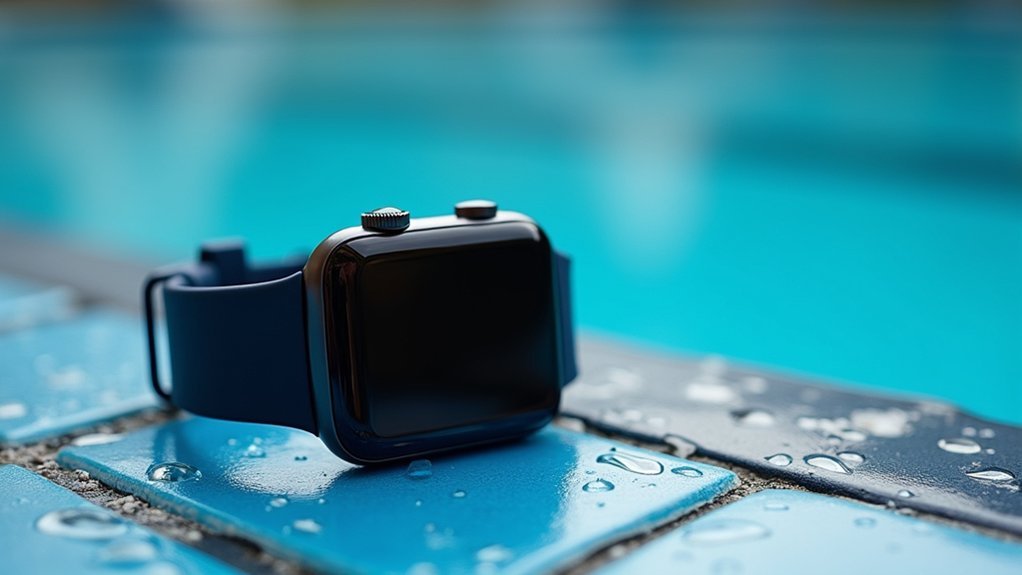
When manufacturers evaluate swimming wearables, they must choose between static testing methods that assess devices under controlled, motionless conditions and dynamic testing that replicates the real-world chaos of actual swimming.
Static testing can’t reveal vital durability issues that only emerge during repetitive swim strokes, like compromised waterproof seals and strap integrity failures.
You’ll find dynamic testing exposes performance degradation that static tests miss entirely. Heart rate accuracy drops considerably during movement, with deviations increasing by 13-56 bpm.
The mechanical stress from arm movements creates sensor interference and threatens battery contacts that remain undetected in static environments.
Dynamic testing validates your wearable’s real-time feedback capabilities across different strokes and intensities, ensuring the device performs reliably when you’re actually swimming—not just sitting motionless in water. Professional mobile systems now provide validated performance analysis that can assess swimming parameters without disrupting natural technique, offering manufacturers better testing benchmarks.
Saltwater Corrosion Protection in Marine-Grade Fitness Trackers
Marine environments present a different challenge than pool testing reveals. When you’re using fitness trackers in saltwater, you’ll face accelerated corrosion that can compromise your device within 30-45 days without proper protection.
Saltwater accelerates corrosion beyond pool conditions, potentially compromising unprotected fitness trackers within just 30-45 days of marine exposure.
Even swim-rated wearables aren’t automatically saltwater-resistant. Marine-grade fitness trackers use 316L stainless steel for enhanced corrosion resistance, but they still require active maintenance. Early detection of component degradation can prevent larger device failures.
Here’s what protects your investment:
- Thorough freshwater rinsing after each saltwater exposure removes corrosive salt residue
- Complete drying prevents water spots and corrosion initiation points
- Regular inspections help identify scratches that compromise protective coatings
- Professional servicing maintains corrosion-resistant component integrity
Real-World Performance Gaps Between Laboratory and Pool Testing
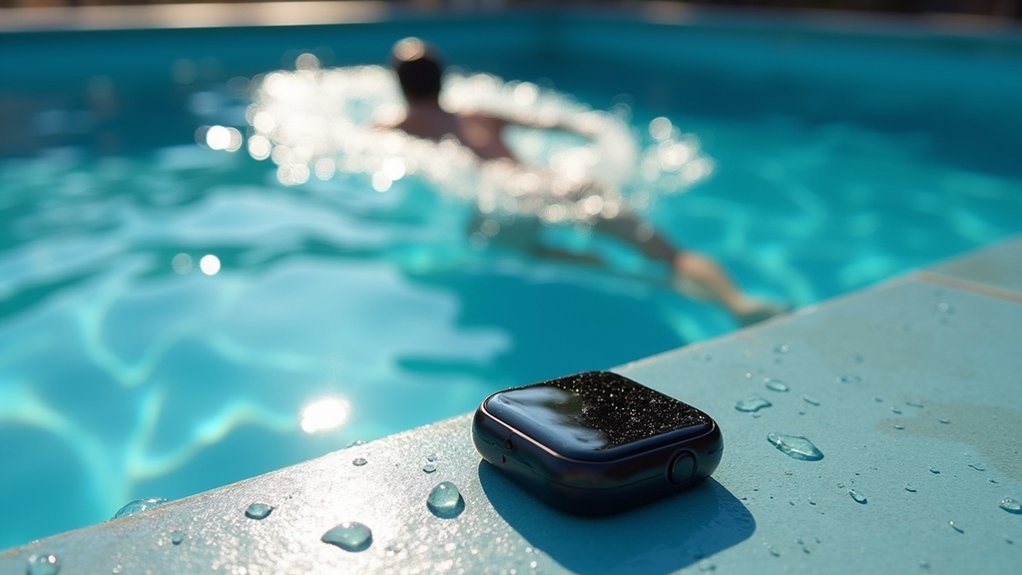
Although manufacturers tout impressive accuracy ratings from controlled laboratory tests, you’ll often discover your swim-rated wearable performs markedly worse during actual pool sessions.
Your heart rate readings can deviate by 13 to 56 bpm compared to dry conditions, with standard deviation worsening by approximately 49 to 52 bpm during swimming. Water presence and arm movement create significant interference that laboratories can’t fully replicate.
You’ll notice accuracy degrades further as swimming intensity increases. Water temperature, pressure, and conductivity interfere with optical and electrical sensors, while mechanical swimming motions cause sensor displacement and signal noise absent in controlled environments.
Your individual technique and intensity variations complicate uniform data validation. Laboratory conditions simply don’t replicate these real-world environmental and biomechanical stressors, creating substantial performance gaps. Pool water chemistry variations add another layer of complexity that home testing kits like the Taylor K-2006 can monitor for swimming conditions, but wearables cannot account for during operation.
Manufacturer Liability and Warranty Coverage for Water Damage Claims
Beyond these performance inconsistencies lies another critical concern: understanding your legal protections when water infiltrates your supposedly swim-rated device.
Manufacturers typically aren’t liable for water damage unless it stems from defective materials or workmanship. Most standard warranties exclude water damage, drops, and spills, leaving you vulnerable despite swim ratings.
Despite swim ratings, standard warranties typically exclude water damage, leaving consumers unprotected unless defective materials or workmanship caused the failure.
You’ll find that misrepresented water resistance claims can create legal liability for manufacturers, but proving this requires evidence.
Your protection options include:
- Extended warranties that specifically cover accidental water damage
- Separate insurance policies designed for wearables and water exposure
- Thorough warranty review to understand exclusions and coverage conditions
- Documentation of proper usage to support potential claims
Understanding these limitations helps you make informed decisions about additional coverage beyond manufacturer warranties. Remember that devices advertise water resistance rather than being completely waterproof, which creates an important distinction in coverage expectations.
Selecting the Right Waterproof Rating for Your Swimming Training Needs
When you’re choosing a swimming wearable, understanding the difference between marketing claims and actual performance can save you from costly disappointments and compromised training data.
Don’t assume 5 ATM automatically means swimming-ready. You’ll need explicit swimming certification, not just depth ratings. For serious training, prioritize devices with IP68 or ISO 22810 standards that account for dynamic water movement.
| Swimming Environment | Minimum Rating Required |
|---|---|
| Pool Swimming | IP68 or 5 ATM (swim-certified) |
| Open Water | ISO 22810 or 10+ ATM |
| Competitive Training | ISO 22810 + stroke recognition |
| Casual Swimming | IP67 minimum |
Your device should include swim-specific features like lap counting and stroke analysis. Modern wearables can collect comprehensive performance metrics including distance per stroke, stroke rate, and underwater time during training sessions. Remember that saltwater and chlorine can degrade seals over time, so regular maintenance is essential regardless of initial ratings.
Frequently Asked Questions
How Do Swim Ratings Improve Stroke Technique for Competitive Swimmers?
You’ll identify stroke inefficiencies through real-time SWOLF scores and stroke counts, enabling immediate technique corrections. Historical data reveals improvement trends, while distance-per-stroke metrics guide your catch and pull phase adjustments for competitive advantage.
Can Wearable Swim Data Help Prevent Swimming-Related Injuries Effectively?
You’ll prevent swimming injuries effectively with wearable data by monitoring fatigue levels, tracking biomechanical patterns, and receiving real-time feedback. Machine learning algorithms predict injury risk with 80% accuracy, enabling immediate technique adjustments.
What Specific Metrics Do Swim Ratings Track During Training Sessions?
You’ll track distance, lap count, stroke types, session duration, stroke rate, SWOLF scores, heart rate, calories burned, stroke length, turn detection, pace, split times, and rest intervals during your swimming sessions.
How Accurate Are Swim Ratings Compared to Manual Coaching Observations?
You’ll find swim ratings less accurate than manual coaching observations. Wearables can overestimate distances by 13-56 bpm and lack contextual factors like technique nuances and psychological elements that coaches naturally observe.
Do Swim Ratings Work Equally Well for All Swimming Strokes?
Swim ratings don’t work equally well for all strokes. You’ll find they’re most accurate for freestyle and backstroke, but considerably less reliable for breaststroke and butterfly due to complex movement patterns.
In Summary
You can’t afford to ignore swim ratings when choosing wearables for aquatic activities. They’re not just marketing numbers—they determine whether your device survives underwater pressure, temperature changes, and chemical exposure. Don’t assume “water-resistant” means “swimming-ready,” and remember that lab conditions don’t always match real-world pool environments. You’ll save money and frustration by selecting the appropriate rating for your specific swimming depth and training intensity from the start.

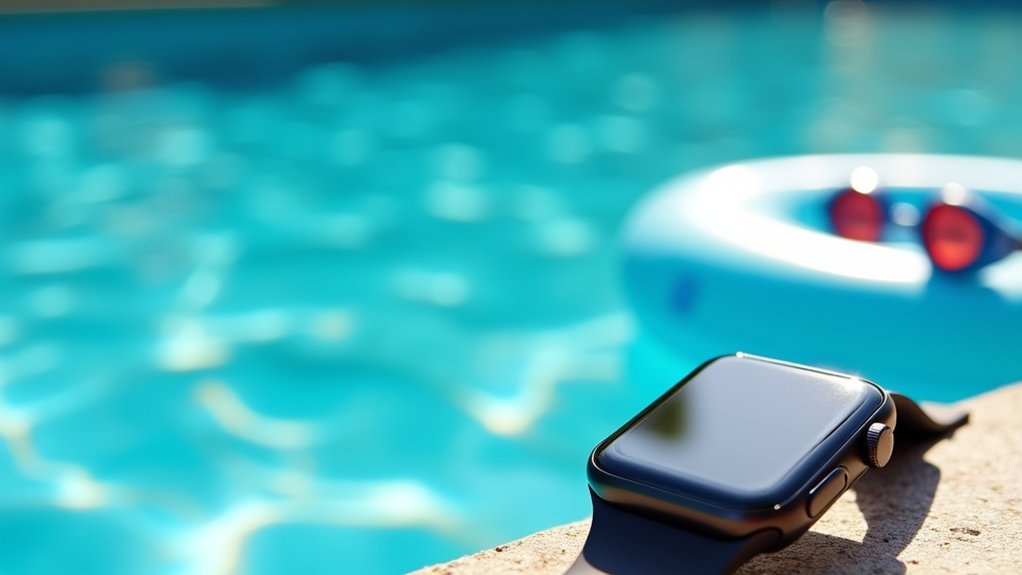



Leave a Reply